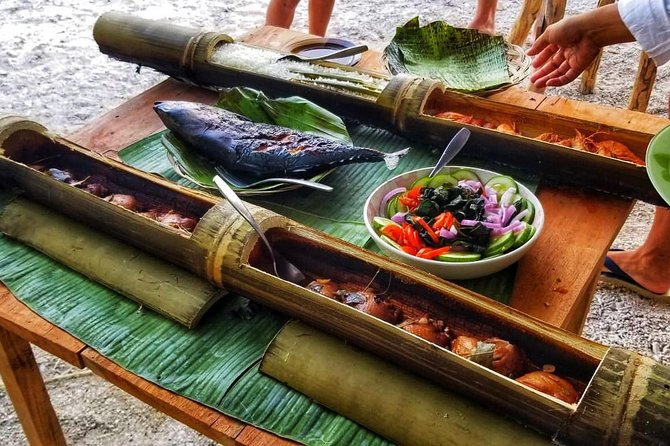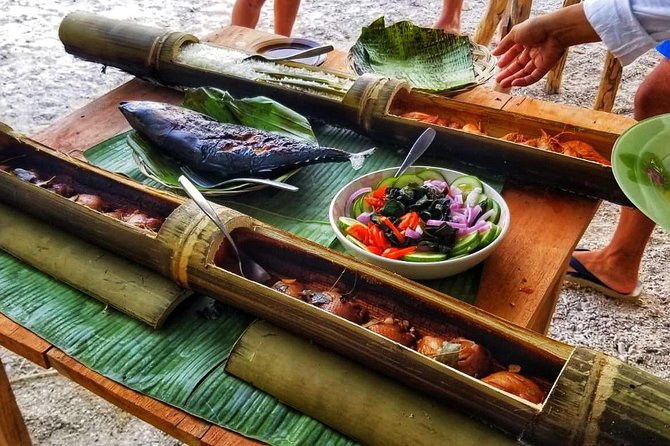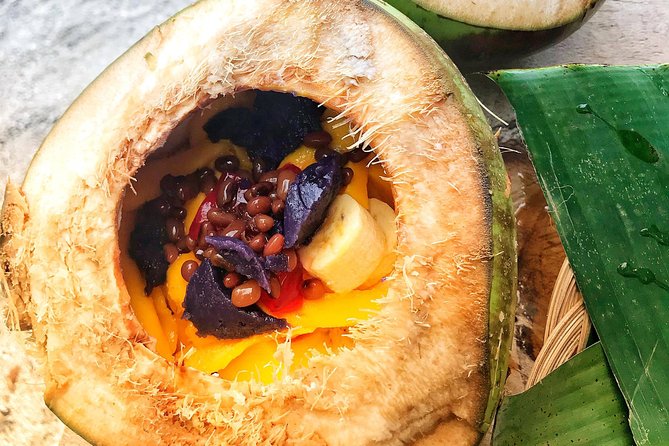In the heart of Filipino culinary tradition, bamboo stands as a symbol of resilience and versatility. Imagine a cooking method where bamboo plays a central role in infusing dishes with a distinct flavor that captivates the senses.
The use of bamboo in Filipino cooking goes beyond mere preparation; it embodies a connection to nature and a reverence for the past. As the aromatic scents waft through the air, one can’t help but wonder about the stories woven into each dish, waiting to be unraveled.
The allure of Traditional Filipino Bamboo Cooking beckons you to uncover a world where flavors and heritage intertwine seamlessly, promising a culinary experience like no other.
Key Takeaways

- Filipino bamboo cooking showcases cultural heritage and culinary innovation.
- Essential tools like bamboo tubes and knives are used for traditional techniques.
- Popular dishes like Bamboo Rice and Bamboo Chicken reflect unique flavors.
- Bamboo cooking promotes health benefits, sustainability, and eco-friendliness.
Here's more tours and experiences happening nearby.
Cultural Significance of Bamboo Cooking

The cultural significance of bamboo cooking lies in its deep-rooted connection to Filipino heritage and traditional culinary practices. With historical roots dating back generations, bamboo cooking has been an integral part of Filipino culinary heritage, showcasing the creativity and resourcefulness of the Filipino people.
Beyond its historical significance, bamboo cooking also represents culinary innovation, as it offers a unique way of preparing and presenting dishes. This traditional method not only serves as a way to cook food but also fosters community bonding, as the process often involves multiple individuals working together.
Through bamboo cooking, Filipinos not only preserve their culinary heritage but also continue to strengthen the bonds within their communities.
Essential Tools and Materials

Bamboo cooking in Filipino culture necessitates specific tools and materials that are fundamental to the traditional culinary practice. Cooking utensils play a crucial role in preparing and serving bamboo-cooked dishes. Filipinos often use bamboo tubes as containers for cooking various dishes, such as rice, vegetables, and meats. These bamboo tubes are essential for imparting a unique flavor to the food while retaining moisture during the cooking process.
Additionally, bamboo skewers are commonly used for grilling meats and vegetables, adding a delicious smoky taste. When it comes to ingredient preparation, traditional tools like bamboo knives and chopping boards are favored for their durability and eco-friendliness. These tools highlight the importance of sustainability and cultural heritage in Filipino bamboo cooking practices.
Traditional Cooking Techniques

Utilizing traditional Filipino methods, cooking with bamboo involves intricate techniques that showcase the rich culinary heritage of the culture. These techniques have been passed down through generations, reflecting cultural practices and traditions unique to the Philippines.
One common technique is using bamboo tubes to steam food, imparting a distinct flavor and aroma to the dishes. Another traditional method is grilling or roasting ingredients inside bamboo stalks over an open flame, enhancing the natural flavors of the food.
These cooking techniques not only add a special touch to the dishes but also highlight the deep-rooted culinary heritage of the Filipino people. Embracing these practices keeps the cultural identity alive and preserves the rich history of Filipino cuisine.
Popular Filipino Bamboo Dishes
Embracing traditional Filipino culinary methods, bamboo dishes showcase a unique blend of flavors and cultural heritage. When exploring Filipino cuisine, bamboo delicacies offer a window into the country’s culinary traditions and bamboo innovations.
Here are some popular Filipino bamboo dishes to try:
- Bamboo Rice (Sinukmani): A sweet rice cake cooked inside bamboo tubes.
- Bamboo Shoot Salad (Utan Bamboo): A refreshing salad made with bamboo shoots and coconut milk.
- Bamboo Tube Rice (Binungey): Glutinous rice cooked with coconut milk and sugar inside bamboo tubes.
- Bamboo Chicken (Tinola sa Bambu): Chicken cooked with ginger, lemongrass, and other spices inside bamboo containers.
These dishes not only offer a unique taste experience but also highlight the rich culinary history of the Philippines.
Health Benefits of Bamboo Cooking
Indulging in traditional Filipino bamboo cooking methods offers a myriad of health benefits that complement the flavors and cultural significance of the dishes.
Bamboo cooking not only enhances the taste of the food but also provides various nutritional benefits. The use of bamboo as a cooking vessel helps retain the food’s natural flavors and nutrients, resulting in healthier and more delicious meals.
Additionally, the unique cooking methods involved in traditional bamboo cuisine contribute to the health advantages it offers. Steaming or grilling food in bamboo allows for the retention of essential vitamins and minerals while requiring minimal oil, promoting a healthier way of cooking.
Embracing bamboo cooking in traditional Filipino cuisine can thus lead to a healthier lifestyle without compromising on taste.
Sustainability and Eco-Friendliness
Transitioning from discussing the health benefits of bamboo cooking, the focus now shifts to exploring the sustainability and eco-friendliness aspects of this traditional Filipino culinary practice.
Here are some key points to consider regarding bamboo sustainability and eco-friendly practices:
-
Renewable Resource: Bamboo is a highly renewable resource, growing much faster than trees and requiring minimal water and no pesticides to thrive.
-
Carbon Sequestration: Bamboo plants absorb more carbon dioxide and release more oxygen than equivalent stands of trees, making them an excellent tool in combating climate change.
-
Durable Construction Material: Bamboo is known for its strength and flexibility, making it a popular choice in traditional architecture and modern sustainable building practices.
-
Minimal Environmental Impact: Bamboo cultivation has a low environmental impact, as it can grow in diverse climates and soil conditions without depleting natural resources.
Tips for Trying Bamboo Cooking at Home
To enhance your culinary skills at home, consider experimenting with bamboo cooking techniques. Home experimentation with bamboo cooking can open up a world of flavor exploration right in your kitchen. Start by sourcing fresh bamboo shoots from local Asian markets or online vendors.
Before using bamboo for cooking, ensure it’s food-grade and safe for consumption. When preparing bamboo for cooking, make sure to peel off any tough outer layers and boil the shoots to remove bitterness. You can then incorporate bamboo shoots into stir-fries, soups, or even steam them as a side dish.
Get creative with your recipes and enjoy the unique taste and texture that bamboo can add to your dishes.
Frequently Asked Questions

Can Bamboo Cooking Methods Be Used With Other Types of Cuisine, or Is It Specifically for Filipino Dishes?
Bamboo cooking methods can be applied to various cuisines, allowing for fusion experimentation. This culinary innovation showcases cultural adaptation beyond Filipino dishes. Its versatility offers a unique way to infuse flavors and techniques from different culinary traditions worldwide.
Are There Any Specific Safety Precautions to Keep in Mind When Using Bamboo for Cooking?
When using bamboo for cooking, it’s important to follow safety precautions like proper handling to prevent burns or splinters. Bamboo offers health benefits, being a natural material, and its sustainability contributes positively to the environment.
How Long Does It Typically Take to Cook a Dish Using Bamboo as a Cooking Vessel?
When cooking a dish using bamboo as a cooking vessel, the cooking time can vary depending on the recipe and ingredients. The bamboo imparts a unique flavor infusion to the dish, enhancing its taste.
Can Bamboo Cooking Be Done Indoors, or Is It Best Suited for Outdoor Cooking?
Indoor bamboo cooking provides versatility in preparing dishes conveniently within the home. On the other hand, outdoor bamboo cooking offers authenticity and connection to nature, enhancing the overall culinary experience with its traditional charm and unique flavor infusion.
Are There Any Specific Types of Bamboo That Are Preferred for Traditional Filipino Cooking Techniques?
When it comes to bamboo varieties for culinary uses, certain types are preferred for their strength and flexibility. These qualities are essential for traditional cooking techniques and hold cultural significance in various cuisines worldwide.
Conclusion
In conclusion, Traditional Filipino Bamboo Cooking offers a glimpse into the rich culinary heritage of the Philippines, showcasing the artistry and cultural significance behind this traditional practice.
From essential tools and materials to popular dishes and health benefits, bamboo cooking is a sustainable and eco-friendly way to experience authentic Filipino flavors.
Try your hand at Bamboo Cooking at home and embark on a delicious journey that captures the essence of Filipino culture and gastronomy.
